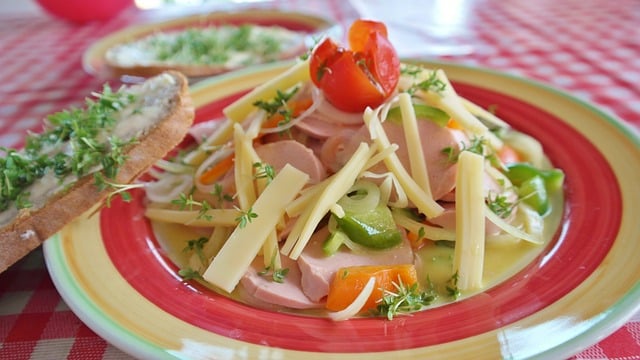Cervelat: What is the Swiss sausage that creates a 'sense of identity'?

If you have ever attended a Swiss barbecue, chances are you have eaten a cervelat, the sausage that has a place of honour in the country’s culinary tradition.
The Germans have their bratwurst and the French their saucisson, but the Swiss will tell you in no uncertain terms that their cervelat trumps them all.
Even the Swiss government is not neutral in its assessment of this staple: “Food creates a sense of identity and home,” it says. “For Switzerland, it’s the cervelat – the nation’s’national sausage.’
“For fans in a football stadium, biting into that barbecued sausage is a ritual," it added.

Grilled cervelat is a national state. Image by Michal Jarmoluk from Pixabay
What exactly is cervelat made of?
Many people will say that it’s better not to know what goes into a sausage — just enjoy it and don’t ask too many questions.
This may have been the case in the 16th century, when these sausages were made from animal brains — which explains its name, cervelat, from Latin cerebrum — but things have evolved since then.
Present-day cervelats, however, are brainless: they are made from pork meat and rind, bacon, and beef. Curing salt and spices are mixed in, and ice is added to bind the ingredients.
It is all ground together into a pink, paste-like consistency and packed into a casing.
The process may sound unappetising, but the end result is not.
Unless you are a vegan or a vegetarian, piping hot, grilled or barbecued cervelats dipped in mustard and eaten with a slice of bread are, as millions of Swiss will tell you, delicious.
Cervelat can also be eaten raw, in a salad: thinly sliced sausage is mixed with chunks of hard cheese (Swiss, of course), and chopped gherkins.
The dressing is made of oil, mustard and mayonnaise all mixed together.

Cervelat salad. Photo: Pixabay
Cervelat: The casing controversy
Don’t read this if you have a sensitive stomach, but while cervelat itself is Swiss, its casing is not.
For decades, these casings had come from the intestines of cow-like Brazilian zebus (we did warn you).
In 2006, however, the European Union tightened its import regulations for animal products from Brazil, due to the risk of transmission of the bovine BSE, also known as mad-cow disease.
Though not a EU member, Switzerland had to comply with the new rule as well.
In what had become known as a national ‘cervelat crisis,’ the production of Switzerland’s favourite sausage came to an abrupt halt, as the country desperately looked for a way to — literally — save its skin.
As it often happens in Switzerland in times of crises, a task force was formed to search for a solution. And in 2008 it found one: using casings from Argentinian and Uruguayan animals was deemed a good alternative.
“In the meantime, the crisis had brought cervelat a great deal of attention and a marked increase in sales,” according to the Swiss National Museum. "The sausage had emerged as a national institution that contains a good portion of globalisation."
In retrospect, it is a good thing that a solution was found and the future of cervelat as a veritable Swiss institution was preserved.
It is even more important now when Switzerland’s two other ‘typical’ foods — chocolate and Gruyère cheese — have been stripped of their 'Swissness.'
READ MORE:
Comments
See Also
The Germans have their bratwurst and the French their saucisson, but the Swiss will tell you in no uncertain terms that their cervelat trumps them all.
Even the Swiss government is not neutral in its assessment of this staple: “Food creates a sense of identity and home,” it says. “For Switzerland, it’s the cervelat – the nation’s’national sausage.’
“For fans in a football stadium, biting into that barbecued sausage is a ritual," it added.

Grilled cervelat is a national state. Image by Michal Jarmoluk from Pixabay
What exactly is cervelat made of?
Many people will say that it’s better not to know what goes into a sausage — just enjoy it and don’t ask too many questions.
This may have been the case in the 16th century, when these sausages were made from animal brains — which explains its name, cervelat, from Latin cerebrum — but things have evolved since then.
Present-day cervelats, however, are brainless: they are made from pork meat and rind, bacon, and beef. Curing salt and spices are mixed in, and ice is added to bind the ingredients.
It is all ground together into a pink, paste-like consistency and packed into a casing.
The process may sound unappetising, but the end result is not.
Unless you are a vegan or a vegetarian, piping hot, grilled or barbecued cervelats dipped in mustard and eaten with a slice of bread are, as millions of Swiss will tell you, delicious.
Cervelat can also be eaten raw, in a salad: thinly sliced sausage is mixed with chunks of hard cheese (Swiss, of course), and chopped gherkins.
The dressing is made of oil, mustard and mayonnaise all mixed together.

Cervelat salad. Photo: Pixabay
Cervelat: The casing controversy
Don’t read this if you have a sensitive stomach, but while cervelat itself is Swiss, its casing is not.
For decades, these casings had come from the intestines of cow-like Brazilian zebus (we did warn you).
In 2006, however, the European Union tightened its import regulations for animal products from Brazil, due to the risk of transmission of the bovine BSE, also known as mad-cow disease.
Though not a EU member, Switzerland had to comply with the new rule as well.
In what had become known as a national ‘cervelat crisis,’ the production of Switzerland’s favourite sausage came to an abrupt halt, as the country desperately looked for a way to — literally — save its skin.
As it often happens in Switzerland in times of crises, a task force was formed to search for a solution. And in 2008 it found one: using casings from Argentinian and Uruguayan animals was deemed a good alternative.
“In the meantime, the crisis had brought cervelat a great deal of attention and a marked increase in sales,” according to the Swiss National Museum. "The sausage had emerged as a national institution that contains a good portion of globalisation."
In retrospect, it is a good thing that a solution was found and the future of cervelat as a veritable Swiss institution was preserved.
It is even more important now when Switzerland’s two other ‘typical’ foods — chocolate and Gruyère cheese — have been stripped of their 'Swissness.'
READ MORE:
Join the conversation in our comments section below. Share your own views and experience and if you have a question or suggestion for our journalists then email us at [email protected].
Please keep comments civil, constructive and on topic – and make sure to read our terms of use before getting involved.
Please log in here to leave a comment.